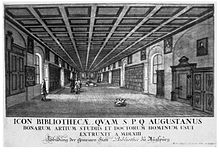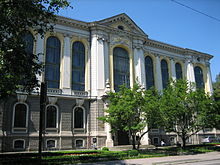State and City Library Augsburg
| State and City Library Augsburg | |
|---|---|
 The State and City Library of Augsburg
|
|
| founding | 1537 |
| Duration | about 460,000 volumes |
| Library type | Regional library |
| place | Augsburg , Bavaria , Germany (built in 1893) |
| ISIL | DE-37 |
| Website | www.sustb-augsburg.de |
The Augsburg State and City Library is one of the most important city and regional libraries in Germany. The current library building on Schaezlerstrasse dates from 1893 and is located in the Bahnhofsviertel district of Augsburg , which belongs to the Bahnhofs- and Bismarckviertel district in the Augsburg city center .
Until 2011, the city of Augsburg was the maintenance provider of the state and city library, which was almost exclusively financed by the city. On December 1, 2012, the library was taken over by the Free State of Bavaria . The Augsburg State and City Library is almost a magazine library . Only in the reading room some are reference books , newspapers and magazines in open access available. Some of the more recent works can be borrowed; the older ones are in the reference inventory .
history
founding
The library was created in 1537 during the Reformation as the city library of the imperial city of Augsburg. Their basis lay in the libraries of the disbanded Carmelite monastery near St. Anna and other Augsburg monasteries. The city library, initially set up in the former Carmelite monastery, was moved to the Dominican monastery in Augsburg in 1544 and was housed in the barefoot monastery in 1548 when the Dominicans returned .
Library in the Annahof
In 1562/1563 a separate building was erected in the Annahof for the then city library. This was the first free-standing, independent library building in modern times in Germany. For a long time, the Augsburg city library was closely connected to the Protestant grammar school near St. Anna . The city librarian had been the rector of the grammar school at St. Anna since the time of Sixtus Birck , a personal union that lasted until 1872. The library and its book inventory were clearly Protestant at this time.
From 1806
With the Peace Treaty of Pressburg (December 26, 1805), Augsburg, which had already been occupied by Bavarian troops on December 21 , lost its imperial freedom and fell to Bavaria. In 1806 Augsburg became the seat of a Swabian provincial or district library, which was combined with the city library in 1810. A large part of the oldest and most valuable books were withdrawn from the Augsburg library by the Kingdom of Bavaria and brought to Munich . In return, the Augsburg library experienced a strong increase in holdings from secularized monasteries in the region under Georg Caspar Mezger in the 19th century (secularization property ). The formerly Protestant library now received a large number of Catholic works, so that today it often combines writings and counter-writings in one house on confessional disputes from this period. In addition, important family and association libraries were added in the 19th and 20th centuries.
New building in 1893
Towards the end of the 19th century there was a great shortage of space both in the district and city library and in the adjacent grammar school near St. Anna. For this reason it was decided to build a completely new building for the library. The previous library building in Annahof was demolished and the grammar school built a larger new building for the school on Fuggerstrasse in its place.
According to the plans of Fritz Steinhäußer (1852–1929), Augsburg city planning officer, a representative new library was built in 1893 on Schaezlerstrasse. The Munich architect Martin Dülfer (1859–1942) was responsible for the facade design and the iron construction . With the new building, the city of Augsburg once again became the sole maintenance provider of the state, district and city libraries . In 1897, the government of the Kingdom of Bavaria and the city government of Augsburg signed a contract on the joint management of the holdings, the financing of which was contractually agreed in 1898 with expenses for the city of 9,000 Reichsmarks and Bavaria of 2,000 Reichsmarks per year.
Establishment and spin-off of the public library
In 1920 the public library opened with 10,000 books as a department of the state, district and city libraries . An extension was made for this, which today serves as a reading room. In 1941 it was renamed the State and City Library . The heavy air raids on Augsburg in World War II were survived without significant losses. The Volksbücherei became independent in 1953 and became today's Stadtbücherei Augsburg .
As a result of the splitting off of the public library and the establishment of the University of Augsburg in 1970, the tasks of a research, archive and regional library came back to the fore.
nationalization
In October 2010, plans of the Augsburg city administration were published, which provide for the division of the holdings and the sale of the historical library building. The reason was the city's financial distress and the state's annual contribution, which has remained unchanged since 1898, of 18,900 euros converted from the Reichsmark. A resolution by the Augsburg city council made it clear that it was not intended to be broken up. A working group on the future of the library was set up. A citizens' initiative that wants to secure the preservation of the library in the previous building has formed as an association. After lengthy negotiations, the State and City Library was nationalized on December 6, 2012 with retroactive effect from December 1, 2012. The name of the library has been retained. Karl-Georg Pfändtner has been the head of the library since January 1, 2017.
Library building
The current library building on Schaezlerstrasse was occupied in 1893. The massive building is presented in a neo-baroque style. On the first and second floors of the symmetrical library building, which is divided into a north and a south wing from the entrance foyer, two Cimelia rooms have been set up, which are accessible via a magnificent staircase.
Around the Stadtpflegeranger , a small green area with old trees on the street Am Alten Einlaß , forms the library building together with the neighboring "Stadtpflegeranger-Schule" ( St. Anna Primary School ), the large house of the "Stadttheater" (today the State Theater Augsburg ) and the Palace of Justice an impressive ensemble . The four buildings belong to the ensemble Fuggerstrasse / Volkhartstrasse / Schaezlerstrasse , which is a comprehensive building ensemble under monument protection and is entered in the Bavarian monument list.
Stocks

With a total of over 540,000 volumes and a large historical inventory of more than 120,000 titles prior to 1800, it is one of the most important city and regional libraries in Germany. With the secularization in Bavaria , more than 60,000 volumes from the monastery libraries in Augsburg and the East Swabian and Eichstätt area were added to the inventory. It has a total of 3,600 manuscript volumes , including 1,000 medieval codices and 2,800 incunabula . Important collections were acquired again and again. In 1846 the library received a donation of around 10,000 volumes from the banker Friedrich von Halder . In 1875, the von Stetten family library followed, with around 8000 volumes . In 1910, the library of the Historical Society for Swabia , comprising around 8,000 volumes, was taken over. Since the beginning of the 20th century, antiquarian books with a focus on typefaces published and printed in Augsburg and Swabia have also been continuously acquired. In 1961 the fourth copy of the famous Missale speciale (formerly Constantiense) was found here.
Affiliated to the library is the Bertolt Brecht Research Center Augsburg , headed by Jürgen Hillesheim . Its holdings include over 3000 volumes of primary and secondary literature on Bertolt Brecht .
literature
- Handbook of the historical book collections in Germany . Vol. 11. Bavaria: A – H. Hildesheim u. a. 1997; Pp. 63-92: Augsburg 1
- Max Spindler , Andreas Kraus : History of Swabia up to the end of the 18th century. Volume 3, part 2. Beck, Munich 2001, ISBN 3-406-39452-3 .
Web links
- State and City Library Augsburg
- State and City Library Augsburg - (Augsburg-Wiki)
- Entry in the Fabian manual
- Initiative State and City Library Augsburg
Individual evidence
- ↑ Max Spindler, Andreas Kraus: History of Swabia up to the end of the 18th century (2001), p. 627
- ↑ Ulrich Heiss: The treasure and the treasure house .
- ^ The Augsburger Zeitung: What to do with Augsburg's historical treasures? , October 9, 2010 (accessed October 14, 2010)
- ^ Augsburger Allgemeine: State and City Library before the split? , October 11, 2010 (accessed October 6, 2015)
- ↑ http://www.initiative-stabi.org/
- ↑ Archived copy ( Memento from November 1, 2012 in the Internet Archive )
- ^ University of Vienna - Institute for Art History: Dr. Karl-Georg Pfändtner
- ↑ List of monuments for Augsburg (PDF) at the Bavarian State Office for Monument Preservation, monument number E-7-61-000-7
- ↑ See also Herrad Spilling: The manuscripts of the State and City Library Augsburg 2 ° Cod 101–250. (= State and City Library Augsburg: Manuscript catalogs of the State and City Library Augsburg. 3). Wiesbaden 1984.
- ^ Paul Geissler: A fourth copy of the Missale speciale in the Augsburg State and City Library. In: Gutenberg-Jahrbuch 1962, pp. 86–93.
- ↑ Fabian Handbook
Coordinates: 48 ° 22 ′ 10.3 ″ N , 10 ° 53 ′ 26 ″ E


